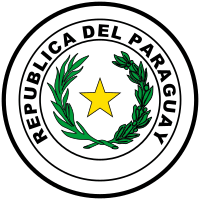1940 Paraguayan constitutional referendum
A constitutional referendum was held in Paraguay on 4 August 1940.[1] It saw voters approve the new constitution.[1]
 |
|---|
| This article is part of a series on the politics and government of Paraguay |
|
Legislature
|
|
Administrative divisions |
|
|
|
|
Background
In 1939, in the midst of a political stalemate, President José Félix Estigarribia dissolved Congress and assumed "temporary" dictatorial powers. The following year, he issued a new constitution. The key institution was a "strong, but not despotic" president who was vested with sweeping powers to suspend civil liberties and take actions that he deemed necessary for the good of the state. The Senate was abolished and the Chamber of Representatives limited in power. A new, corporatist-inspired Council of State was created to represent interests in business, farmers, bankers, the military, and the Roman Catholic Church.[2][3]
Results
| Choice | Votes | % |
|---|---|---|
| For | 92.4 | |
| Against | 7.6 | |
| Invalid/blank votes | – | |
| Total | 100 | |
| Registered voters/turnout | 80 | |
| Source: Direct Democracy | ||
gollark: > what 'web project'; this is heresyminoteaur-rs
gollark: THREE files! my web project.
gollark: ~30 seconds for regular incremental compiles.
gollark: > I still don't know why it'd take that long lol215 dependency crates.
gollark: That looks more magenta than pink.
References
- Nohlen, D (2005) Elections in the Americas: A data handbook, Volume II, p428 ISBN 978-0-19-928358-3
- Thomas C. Bruneau. "Constitutional Development". Paraguay: A country study (Dannin M. Hanratty and Sandra W. Meditz, eds.). Library of Congress Federal Research Division (December 1988).

- Richard S. Sacks. "Historical Setting". Paraguay: A country study (Dannin M. Hanratty and Sandra W. Meditz, eds.). Library of Congress Federal Research Division (December 1988).

This article is issued from Wikipedia. The text is licensed under Creative Commons - Attribution - Sharealike. Additional terms may apply for the media files.